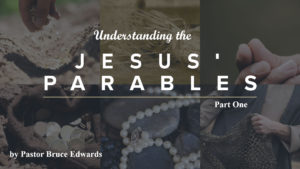Understanding the Parables of Jesus
UNDERSTANDING THE PARABLES OF JESUS
Introduction
 Today we are beginning a series on the parables of Jesus. Jesus used parables to help teach spiritual truths about the meaning of the Kingdom of God, the importance of prayer, the nature of love, and other important topics. They are found in the Synoptic Gospels (Matthew, Mark, and Luke) They form approximately one third of his recorded teachings.
Today we are beginning a series on the parables of Jesus. Jesus used parables to help teach spiritual truths about the meaning of the Kingdom of God, the importance of prayer, the nature of love, and other important topics. They are found in the Synoptic Gospels (Matthew, Mark, and Luke) They form approximately one third of his recorded teachings.
What is a Parable
According to Merriam-Webster, the definition of a parable is “usually a short, fictitious story that illustrates a moral attitude or a religious principle. Jesus used parables to make comparisons of spiritual matters to earthly stories to help His followers better understand the things He was trying to teach them. Jesus used stories about mustard seeds, pearls and wine-skins. He spoke about lost coins, stray sheep, and buried treasure all to help us better understand the principles of the kingdom. A parable, generally speaking, is a short story employed as an object lesson.
Number of Parables
The precise number of parables in the Bible varies based on different definitions of what a parable is. Thirty-eight seems to be the most settled-upon number yet there are slight variations in what makes up that list of 38. While some parables are clearly labeled as “parables” many are not. I am listing 30 parables here that seem to be the most widely accepted as a “parable of Jesus.
Here is that list of 30 parables. I have listed them by the books they are found in.
Matthew alone
- Hidden Treasure (Matt 13:44)
- Pearl (Matt 13:45–46)
- Net (Matt 13:47–48)
- Unmerciful servant (Matt 18:23–35)
- Two sons (Matt 21:28–32)
- Wedding Banquet (Matt. 22:2-14
- The Weeds (Matt 13:24-30)
- Ten virgins (Matt 25:1–13)
- Talents (Matt 25:14–30)
Mark alone
- Parable of the Growing Seed (Mark 4:30-32)
Luke alone
- Good Samaritan (Luke 10:30–35)
- Rich fool (Luke 12:16–21)
- Barren fig tree (Luke 13:6–9)
- Great Banquet (Luke 14:16-24)
- The Lost Coin (Luke 15:8-10
- Prodigal and older son (Luke 15:11–32)
- Shrewd Steward (Luke 16:1–8)
- Unworthy servants (Luke 17:7–10)
- Persistent Widow (Luke 18:2–5)
- Pharisee and tax collector (Luke 18:10–14)
Matthew and Luke
- Wise and foolish builders (Matt 7:24–27, Luke 6:47–49)
- Yeast/Leaven (Matt 13:33, Luke 13:20–21)
- The Lost Sheep (Matt. 18
- Thief in the night (Matt 24:42–44, Luke 12:39–40)
- Stewards (Matt 24:45–51, Luke 12:42–46)
Parables in all three synoptic Gospels
- Parable of New Wine Skin and Cloth (Matt 9:16-17, Mark 2:21-22, Luke 5:36-38)
- Parable of Lamp Stand ( Matt 5:14-16, Mark 4:21-22 Luke 8:16-17)
- Sower/Soils (Matt 13:3–9, Mark 4:3–9, Luke 8:5–8)
- Mustard seed (Matt 13:31–32, Mark 4:30–32, Luke 13:18–19)
- Tenants (Matt 21:33–39, Mark 12:1–9, Luke 20:9–16)
How to Understand the Parables
Often the people Jesus was speaking to including the disciples did not understand the parables He was sharing. Some times after Jesus finished the disciples would ask Jesus to explain what the parable to them. (Mt. 13:36. 15:15, Mk. 4:13, Lk. 8:9) So, is there a way for us to understand these seemly puzzling stories? Yes!
Here are 5 Tips to help you –
Consider the Context.
Parables, like all Scripture, need to be interpreted in the context of the surrounding text. So, figure out – 1) why Jesus is telling the story; 2) who is He speaking to; and 3) whats happening (the event, occasion, setting, etc)
Identify the main Character.
Parables often utilize the figure of a father, manager, or king in representation of God. The remaining characters interact with his authority and grace, and teach us the impact of those responses.
Determine what the main Point is.
Parables usually have one main point and understanding the parable and all the details flow from that main point. After all the reason Jesus is telling the parable is because of this main point. Don’t get distract by other details and miss the main point.
Identify the two things being compared.
Parables usually compare two ideas or concepts like the kingdom of heaven to something physical. As you look at the two things being compared, try to look for clues as to why the two things were being compared.
Focus on the ending.
The ending of parables is very important. Some parables are very short thus they are the ending. However, while longer parables share a lot of important details along the way, the key to understanding the implications of the parable is often found in its conclusion
The parables of Jesus are just as relevant to us today as they were when He first shared them. Take time to read and study them. Use these five tips to help you and then ask the Holy Spirit to teach you how to you can apply them to your life.
7 Key Parables
The parables of Jesus provide us timeless lessons that continue to impact our lives today. Each parable offers valuable insights into the character of God, the nature of humanity, and the path to spiritual growth. All of the parables of Jesus are important, but over the next few weeks we are going to explore in depth the following 7 key parables.
- PARABLE OF SOWER OR SEED
- PARABLE OF MUSTARD SEED
- PARABLE OF THE TENANTS
- PARABLE OF THE TALENTS
- PARABLE OF THE GOOD SAMARITAN
- PARABLE OF THE PRODIGAL SON
- PARABLE OF THE YEAST
Until the next time be super blessed!


